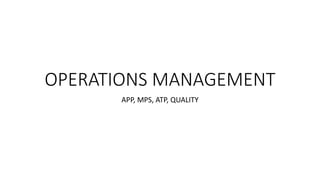Aggregate production planning (APP) is an intermediate-range capacity planning process that typically covers a time horizon of 2 to 18 months. The goal of APP is to achieve a production plan that will effectively utilize the organization's resources to satisfy demand. APP deals with determining the optimal levels of resources like workforce, production rate, and inventory to balance expected demand. Common APP strategies include maintaining a level workforce/capacity or adjusting workforce/capacity to match demand in each period. Mathematical techniques can be used to evaluate alternative APP plans.






























































































